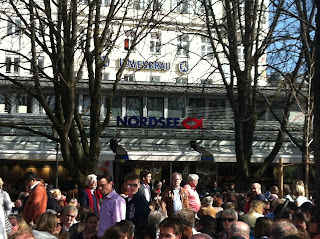Here are some fun things to do in Munich's city centre ...
Gärtnerplatz
A lovely circular square with shops, cafes, and home of the Gärtnerplatz Theatre (also called State Theater) for ballet and music.
Viktualienmarkt
8am - 8pm, Monday through Saturday (many shops close at 6pm).
Large open air market for just about everything you could want. Viktualienmarkt evolved from a farmer's market to an open air market of just about everything, and is a favorite for the gourmets. Flowers, exotic fruit, fresh fruit juice, game, poultry, spices, cheese, fish, traditional hand-made gifts and decoratives, biergarten, restaurants, pubs, et al.
Stroll from Viktualienmarkt to Marienplatz
Marienplatz
Munich's main square since 1158, 'Mary's Square', it is the central square in the city center. The square was named after a column in the center of the square named Mariensäule because it has the Virgin Mary at its top. It was erected in 1638 in celebration of the end of the Swedish occupation. In the middle ages the square was home to both markets and tournaments. There are many shops, cafes, Ludwig Beck department store, Neues Rathaus, Altes Rathaus, ...
Neues Rathaus on Marienplatz
'New Town Hall' is situated on the north side of Marienplatz and is extremely impressive. It has the famous Glockenspiel as part of the amazing architecture.
Neues Rathaus' Glockenspiel
15 minute show daily at 11am viewed from the square on Marienplatz. Plus noon and 5pm between March and October.
Definitely a must see!
43 bells and 32 life-sized figures re-enacts 16th century stories. The top portion shares the story of story of the marriage of Duke Wilhelm V, founder of the Hofbräuhaus, and Renata of Lorraine. A jousting contest featuring life-sized knights represents Bavaria (blue & white) and Lothringen (red & white). Bavaria wins (of course). The bottom portion is Schäfflertanz, 'The Cooper's Dance.' Forklore has it that in 1517 it was a year of plague in Munich. The coopers are said to have danced through the streets of Munich to bring a confident and fresh energy to everyone's mood. Loyal to the duke, the Cooper's dance symbolized perseverance and loyalty to authority through difficult times. The dance is now performed every seven years during Fasching, Carnival in Germany, Austria, and Switzerland. The dance happened at this year's Carnival.
Head to the one of the upper floors of the bookstore across from the Glockenspiel for a better view.
Altes Rathaus
'Old Town Hall' is on the eastern side of the square. It was destroyed in World War II but rebuilt after the original neo-gothic style. It's now home to Spielzeugmuseum, Munich’s toy museum of historic toys from both Europe and the U.S.
Streets surrounding Marienplatz
Still to come:
Gärtnerplatz
A lovely circular square with shops, cafes, and home of the Gärtnerplatz Theatre (also called State Theater) for ballet and music.
Viktualienmarkt
8am - 8pm, Monday through Saturday (many shops close at 6pm).
Large open air market for just about everything you could want. Viktualienmarkt evolved from a farmer's market to an open air market of just about everything, and is a favorite for the gourmets. Flowers, exotic fruit, fresh fruit juice, game, poultry, spices, cheese, fish, traditional hand-made gifts and decoratives, biergarten, restaurants, pubs, et al.
Stroll from Viktualienmarkt to Marienplatz
 |
| St Peter's Church |
Marienplatz
Munich's main square since 1158, 'Mary's Square', it is the central square in the city center. The square was named after a column in the center of the square named Mariensäule because it has the Virgin Mary at its top. It was erected in 1638 in celebration of the end of the Swedish occupation. In the middle ages the square was home to both markets and tournaments. There are many shops, cafes, Ludwig Beck department store, Neues Rathaus, Altes Rathaus, ...
'New Town Hall' is situated on the north side of Marienplatz and is extremely impressive. It has the famous Glockenspiel as part of the amazing architecture.
Neues Rathaus' Glockenspiel
15 minute show daily at 11am viewed from the square on Marienplatz. Plus noon and 5pm between March and October.
Definitely a must see!
43 bells and 32 life-sized figures re-enacts 16th century stories. The top portion shares the story of story of the marriage of Duke Wilhelm V, founder of the Hofbräuhaus, and Renata of Lorraine. A jousting contest featuring life-sized knights represents Bavaria (blue & white) and Lothringen (red & white). Bavaria wins (of course). The bottom portion is Schäfflertanz, 'The Cooper's Dance.' Forklore has it that in 1517 it was a year of plague in Munich. The coopers are said to have danced through the streets of Munich to bring a confident and fresh energy to everyone's mood. Loyal to the duke, the Cooper's dance symbolized perseverance and loyalty to authority through difficult times. The dance is now performed every seven years during Fasching, Carnival in Germany, Austria, and Switzerland. The dance happened at this year's Carnival.
Head to the one of the upper floors of the bookstore across from the Glockenspiel for a better view.
Altes Rathaus
'Old Town Hall' is on the eastern side of the square. It was destroyed in World War II but rebuilt after the original neo-gothic style. It's now home to Spielzeugmuseum, Munich’s toy museum of historic toys from both Europe and the U.S.
 |
| Altes Rathaus, viewed from Viktualienmarkt |
Streets surrounding Marienplatz
 |
| Excavation. |
Still to come:
- (More) Things To Do & See In München's City Centre area
- Public Transportation
- Things To Do & See Outside City Centre, and Outside of München






















No comments:
Post a Comment